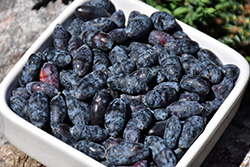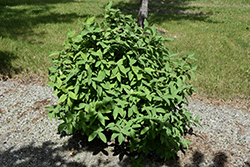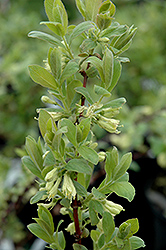Height: 5 feet
Spread: 4 feet
Sunlight:
![]()
![]()
Hardiness Zone: 2a
Other Names: Sweetberry Honeysuckle
Description:
An interesting hardy shrub with clean foliage and delicious bluish-purple berries that are edible; dense growing habit, must have another honeyberry variety for cross pollination; selected for better fruit production and higher yields
Edible Qualities
Borealis Honeyberry is a medium-sized shrub that is commonly grown for its edible qualities, although it does have ornamental merits as well. It produces blue round berries which are usually ready for picking from late spring to early summer. The berries have a sweet taste.
The berries are most often used in the following ways:
- Fresh Eating
- Preserves
Features & Attributes
Borealis Honeyberry features subtle white flowers along the branches in early spring. It has green deciduous foliage. The narrow leaves do not develop any appreciable fall colour. It features an abundance of magnificent blue berries in late spring.
This is a dense multi-stemmed deciduous shrub with a more or less rounded form. Its average texture blends into the landscape, but can be balanced by one or two finer or coarser trees or shrubs for an effective composition. This plant will require occasional maintenance and upkeep, and is best pruned in late winter once the threat of extreme cold has passed. It is a good choice for attracting butterflies to your yard. It has no significant negative characteristics.
Aside from its primary use as an edible, Borealis Honeyberry is sutiable for the following landscape applications;
- Mass Planting
- Hedges/Screening
- General Garden Use
- Orchard/Edible Landscaping
Planting & Growing
Borealis Honeyberry will grow to be about 5 feet tall at maturity, with a spread of 4 feet. It tends to fill out right to the ground and therefore doesn't necessarily require facer plants in front, and is suitable for planting under power lines. It grows at a medium rate, and under ideal conditions can be expected to live for approximately 20 years. While it is considered to be somewhat self-pollinating, it tends to set heavier quantities of fruit with a different variety of the same species growing nearby.
This shrub is quite ornamental as well as edible, and is as much at home in a landscape or flower garden as it is in a designated edibles garden. It does best in full sun to partial shade. It prefers dry to average moisture levels with very well-drained soil, and will often die in standing water. It is not particular as to soil type or pH. It is highly tolerant of urban pollution and will even thrive in inner city environments. This is a selected variety of a species not originally from North America.
Disclaimer - This resource is provided for informational purposes only and does NOT reflect current availability. Inventory varies seasonally, so we cannot guarantee that every plant will be in stock at all times - please contact your favourite GardenWorks location directly for current availability. It does not include our entire inventory of plants, so be sure to visit GardenWorks to see varieties that may not be represented on this list.



